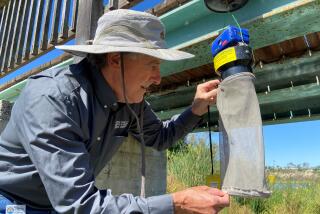AIDS Keeps Expanding Its Deadly Reach : Statistics: In 1990, 457 county residents, including two children, contracted the disease, which claimed 311 lives.
Signaling that the AIDS epidemic remains out of control, the number of new cases in Orange County increased by 32% in 1990 as 457 residents, two of them children, contracted the deadly disease. Also last year, 311 people died of AIDS or related conditions.
“This is a continually expanding epidemic,” said Dr. George Gellert, deputy Orange County Health officer and the county’s new epidemiologist. “Our locality is a microcosm of the country and California. And we expect the incidence of AIDS to continue to rise as more people who are infected with the disease shift from infected to clinically symptomatic.”
The jump in reported cases was the greatest since 1987, when the number of people with AIDS surged 67% from the previous year.
In fact, AIDS cases in Orange County last year increased at a sharper rate than that recorded statewide or nationally. From 1989 to 1990, AIDS cases rose 17.8% in California, with 7,668 cases reported, according to the state Department of Health Services. The increase for the same period was 13.56% across the nation, with 43,339 cases reported, according to the National Centers for Disease Control in Atlanta, Ga.
But Penny Weismuller, Orange County’s manager for disease control, cautioned that part of the local increase may be due to improved efforts last year in tracking AIDS cases. Staff vacancies hampered her agency’s surveillance efforts in 1989, Weismuller said.
Still, the epidemic is spreading since it was first noted here 10 years ago. “Every year we’re seeing more cases,” Weismuller said. “In the best of all possible worlds, the epidemic would be over with. And it’s not.”
In addition to 1990’s 457 new cases of people with the acquired immune deficiency syndrome, 178 Orange County residents discovered they were infected with the virus that causes AIDS and 63 developed AIDS-related problems.
The virus, which is transmitted through sexual intercourse and contaminated needles or from a mother to her newborn child, breaks down the body’s immune system. When that system fails, those afflicted with the human immunodeficiency virus can develop other life-threatening illnesses, including pneumonia and forms of cancer.
As in previous years, AIDS remained most prevalent here among gay and bisexual men, with white males accounting for 82.1% of those infected. Also, 85.2% with AIDS said they were gay or bisexual men and 43.4% of those infected were between the ages of 30 and 39.
Still, health officials are worried about a new risk group--heterosexual women. In Orange County, their numbers are rising, from 57 women with AIDS in 1989 to 76 in 1990. Though the numbers here are small--just 4% of last year’s new cases--federal officials warn that across the nation, AIDS is spreading more rapidly among women than men. By 1991, they say, infection with that virus will be one of the top five causes of death for young women.
Also a concern are babies with AIDS. Last year only three Orange County babies were reported as having AIDS, contracted at birth through their infected mothers. But Weismuller suggested that some physicians may not be reporting these small patients to public health officials. For now, some 40 infants infected with the AIDS virus are being monitored here, Weismuller said, adding, “It’s a more slowly growing problem.”
Nonetheless, local health officials took heart in some of the 1990 statistics. They noted that AIDS was not increasing in leaps and bounds as it was in the early 1980s when cases literally doubled and tripled from one year to the next.
They were also pleased that the incidence of AIDS in Latino and black communities has remained relatively low--with only 12.3% of cases among Latinos, 2.9% of all cases among blacks and 2.7% among other races, including Asians. (The latest census showed that Latinos comprise 23% of the county’s population, blacks 2% and Asians 10%).
Gellert said officials here are not sure why the incidence of AIDS among minorities here remains low--and dramatically lower than that experienced in East Coast cities, such as New York, where blacks and Latinos frequently comprise 40% of all AIDS cases.
One explanation: “Our population is more recently arrived to the U.S.--less acculturated,” Gellert said. “And acculturation frequently involves high risk behaviors, a decrease in monogamy and high-risk partners like intravenous drug users.”
Conversely, one Latino health expert worried that lack of acculturation may contribute to a growing problem.
“Men who come here from Mexico feel like they can now express themselves sexually,” said Loren Lewis, community educator with a Garden Grove project, Ogar Latino Projecto SIDA (Home for Latino AIDS Project).
“In the city of Santa Ana, there are a lot of single men, uneducated, coming from Mexico who suddenly find themselves with a lot more sexual liberty. They work so much--and they have unprotected sex on weekend,” Lewis said.
While the number of AIDS cases is growing in the county, Lewis and other health officials emphasize that early intervention with drugs such as zidovudine (formerly known as AZT) has kept many patients alive and in reasonable health for years. Also, those with full-blown AIDS now live longer, an average of 24 to 36 months instead of just 12 to 18 months as in in the mid-1980s, said Jim Singleton, a research specialist with the state Office of AIDS. When Gary Costa, a community educator with the AIDS Response Program in Garden Grove, learned in 1984 that he had tested positive for the AIDS virus, “I was told that you had about two years to live. So I spent my life savings. I sold my house and prepared to die. Four or five years later, I was still alive.”
As it turned out, Costa said, “I’m very healthy.”
Costa is concerned that the public has grown complacent about AIDS.
“Ten years into this epidemic, to many people it’s old news, it’s not such an urgent situation any more. And people have reverted back to old ways. . . . People have been practicing safe sex for 10 years now and a lot of them are tired of it.”
In view of that, Costa and another volunteer from the AIDS Response Program have increased their outreach efforts. Three nights a week, Costa visits gay bars in Orange County and Long Beach, where he passes out condoms.
Many people, especially those in their 20s, continue to deny that they are at risk for AIDS, said David Souleles, director of sexual health at UC Irvine.
“I can stand up in front of a classroom of 300 college students and ask, ‘What’s AIDS?’ and somebody will tell me what it is. I’ll ask, ‘What do you do to lower your risk?’ And they’ll say, ‘Use latex condoms.’ And then I ask, ‘How many of you are doing that?’ And they’ll chuckle, ‘Yeah. Yeah. We know,’ ” Souleles recounted.
“Nobody is talking about AIDS as much as they used to,” Souleles continued. Quoting national statistics, he noted, “It’s the second leading cause of death for men 25 to 44 but students around here are much more worried about colds and the flu and taking their midterm next week. They don’t think of it in terms of 10 years down the line.”
AIDS Cases in Orange County Number of new cases reported ‘80: 1 ‘81: 3 ‘82: 7 ‘83: 20 ‘84: 56 ‘85: 94 ‘86: 159 ‘87: 265 ‘88: 318 ‘89: 345 ‘90*: 457 Total cases: 1,725 Total deaths: 1,093 As of Dec. 31, 1990 Deaths in 1990: 311, including two children-one from blood transfusion and one from perinatal transmission. Adult victims, by exposure category** Male homosexual or bisexual: 85% IV drug user: 5% High-risk heterosexual contact: 3% Blood transfusion: 2% Hemophillac coagulation disorder: 1% Unknown: 3% Reported case percentage change from prior year ‘86: +69% ‘87: +67% ‘88: +20% ‘89: +8% ‘90*: +32% Highest AIDS rates by city, 1990 (Cases per 1,000 population) City: Rate Laguna Beach: 1.71 Dana Point: 0.41 Newport Beach: 0.30 Costa Mesa: 0.29 San Juan Capistrano: 0.29 * Estimated. ** Pediatric cases equal less than 1% Source: Orange County Health Care Agency
More to Read
Sign up for Essential California
The most important California stories and recommendations in your inbox every morning.
You may occasionally receive promotional content from the Los Angeles Times.










